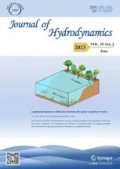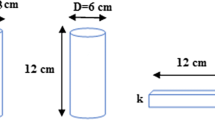Abstract
The Kam Tin Main Drainage Channel (KTMDC) is an important river for the city drainage in Hong Kong. The roughness and its variations have an obvious effect on the flood control capacity and the flow capacity. So physical model tests are designed to study the KTMDC. Due to its complex channel structure, the tests are completed in two steps. In Step 1, the energy loss is measured along the main channel without inflows, with all inflows and outflows being sealed. In Step 2, all the inflow and outflow structures are measured, with the sealed inflows and outflows being opened on the basis of Step 1. In each step, two schemes are employed. One of the key issues is the choice of suitable materials to make the model’s roughness similar to that of the prototype. According to the gravity similarity criterion, the 1:25 scale model is built, with the main channel made of Perspex. The facing slopes of the grasscrete and the stone masonry need to be roughened. A kind of the nylon net is selected to simulate the roughness of the stone masonry and the plastic lawn for the grasscrete facing slope. For the different structure reaches, the roughness coefficients are estimated based on the hydraulic theory. The rationality of the test results is verified in this study. The results of testing can provide a reliable basis for the renovation, the expansion, the optimization of this channel.
Similar content being viewed by others
References
WANG X. Y., YANG Q. Y. and LU W. Z. et al. Effects of bed load movement on mean flow characteristics in mobile gravel beds [J]. Water Resources Management, 2011, 25(9): 2781–2795.
HUAI Wen-xin, HAN Jie and ZENG Yu-hon. et al. Velocity distribution of flow with submerged flexible vegetations based on mixing-length approach [J]. Applied Mathematics and Mechanics (English Edition), 2009, 30(3): 343–351.
FERRO V. Flow resistance in gravel-bed channels with large-scale roughness [J]. Earth Surface Processes and Landforms, 2003, 28(12): 1325–1339.
HOOVER T. M., ACKERMAN J. D. and JOSEF D. A. Near-bed hydrodynamic measurements above boulders in shallow torrential streams: Implications for stream biot [J]. Journal of Environmental Engineering and Science, 2004, 3(5): 365–378.
PENA E., ANTA J. and PUERTAS J. et al. Estimation of drag coefficient and settling velocity of the cockle cerastpderma edule using Particle Image Velocimetry (PIV) [J]. Journal of Coastal Research, 2008, 24(4, suppl.): 150–158.
WU C. L., CHAU K. W. and HUANG J. S. Modelling coupled water and heat transport in a soil-mulch-planta-tmosphere continuum (SMPAC) system [J]. Applied Mathematical Modelling, 2007, 31(2): 152–169.
CHENG C. T., CHAU K. W. Flood control management system for reservoirs in Chin [J]. Environmental Modelling and Software, 2004, 19(2): 1141–1150.
LU W. Z., LEUNG A. Y. T. A preliminary study on potential of developing shower/laundry wastewater recla-mation and reuse system [J]. Environmental and Public Health Management, 2003, 52(9): 1451–1459.
NENAL Laounia, YAN Zhong-min and XIA Ji-hong. Study of the flow through non-submerged vegetation [J]. Journal of Hydrodynamics, 2005, 17(4): 498–502.
YANG Sheng-fa, HU Jiang and LI Dan-xu. et al. Some new data formulas for resistance flow in fluvial open channels [J]. Journal of Hydrodynamics, 2011, 23(4): 527–534.
KALYANAPU A. J., BURIAN S. J. and MCPHERSON T. N. Effect of land use-based surface roughness on hydrologic model output [J]. Journal of Spatial Hydrology, 2009, 9(2): 51–71.
WANG X. Y., SUN Y. and LU W. Z. et al. Experimental study of the effects of roughness on the flow structure in a gravel-bed channel using particle image velocimetry [J]. Journal of Hydrologic Engineering, 2011, (9): 710–716.
CHANSON H. Unsteady turbulence in tidal bores: Effects of bed roughness [J]. Journal of Waterway, Port, Coastal, and Ocean Engineering, 2010, 136(5): 247–265.
ARCEMENT G. J., SCHNEIDER V. R. Guide for selecting Manning’s roughness. Coefficients for natural channels and flood plains [R]. United States Geological Survey Water-supply, Paper 2339, 1989.
WANG Guang-qian, HUANG Yue-fei and WEI Jia-hu. et al. Identification of roughness-coefficient value for the channel of the south-to-north water transfer(middle line) project [J]. South-to-North Water Transfers and Water Science and Technology, 2006, 4(1): 8–14(in Chinese).
SHI Bing, WANG Chuan-yuan and YIN Ze-ga. et al. Effect of vegetation submerged in river on the roughness coefficient [J]. Journal of Ocean University of China, 2009, 39(2): 295–298(in Chinese).
ZHANG Wei, ZHONG Chun-xin and YING Han-hai. Experimental study on hydraulic roughness of revetment with grass cover [J]. Advances in Water Science, 2007, 18(4): 483–489(in Chinese).
Author information
Authors and Affiliations
Corresponding author
Additional information
Biography: WANG Tao (1975-), Female, Master, Senior Engineer
Rights and permissions
About this article
Cite this article
Wang, T., Yang, Kl., Guo, Xl. et al. Experimental Study Hydraulic Roughness for Kan Tin Main Drainage Channei in Hong Kong. J Hydrodyn 24, 776–784 (2012). https://doi.org/10.1016/S1001-6058(11)60303-X
Received:
Revised:
Issue Date:
DOI: https://doi.org/10.1016/S1001-6058(11)60303-X



